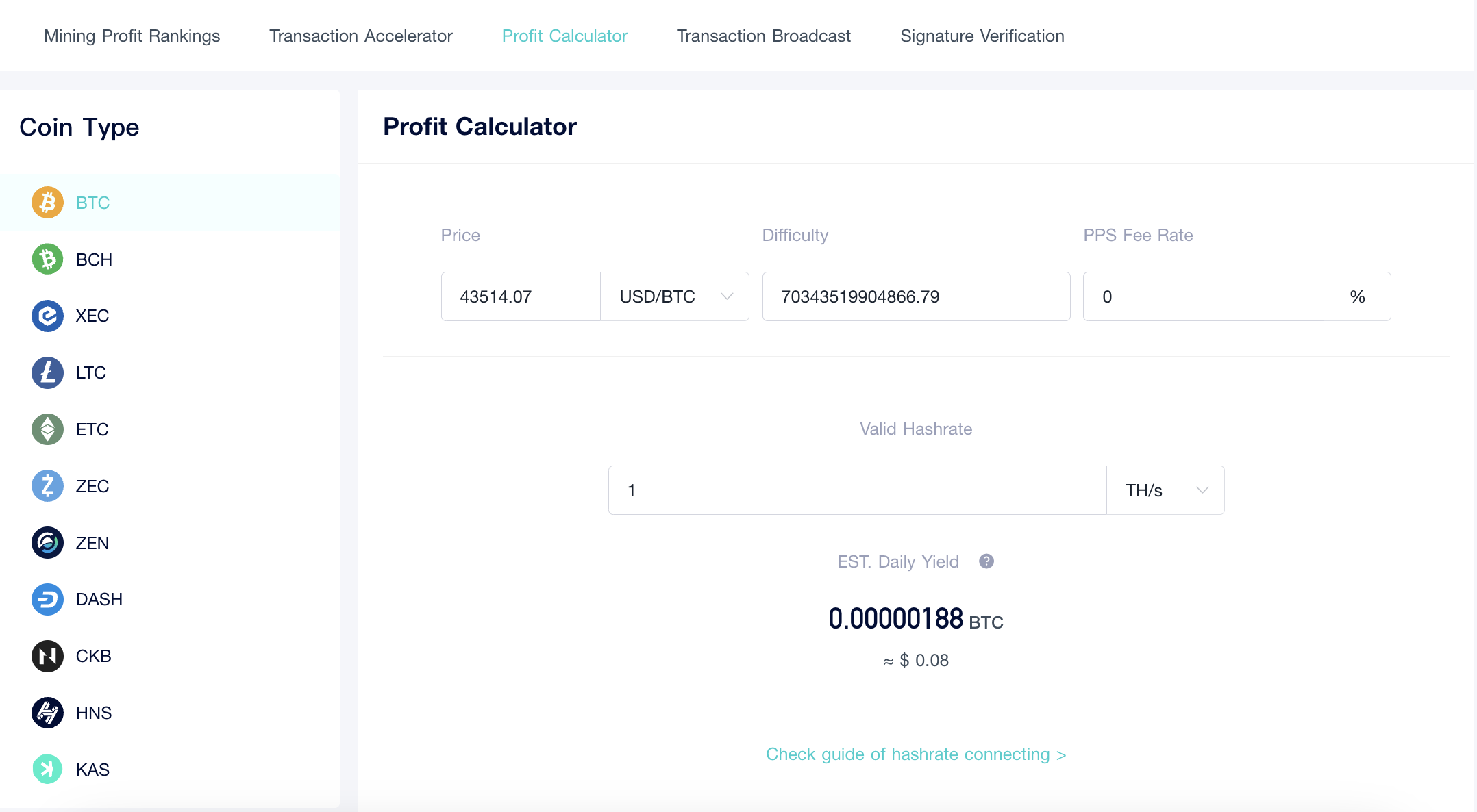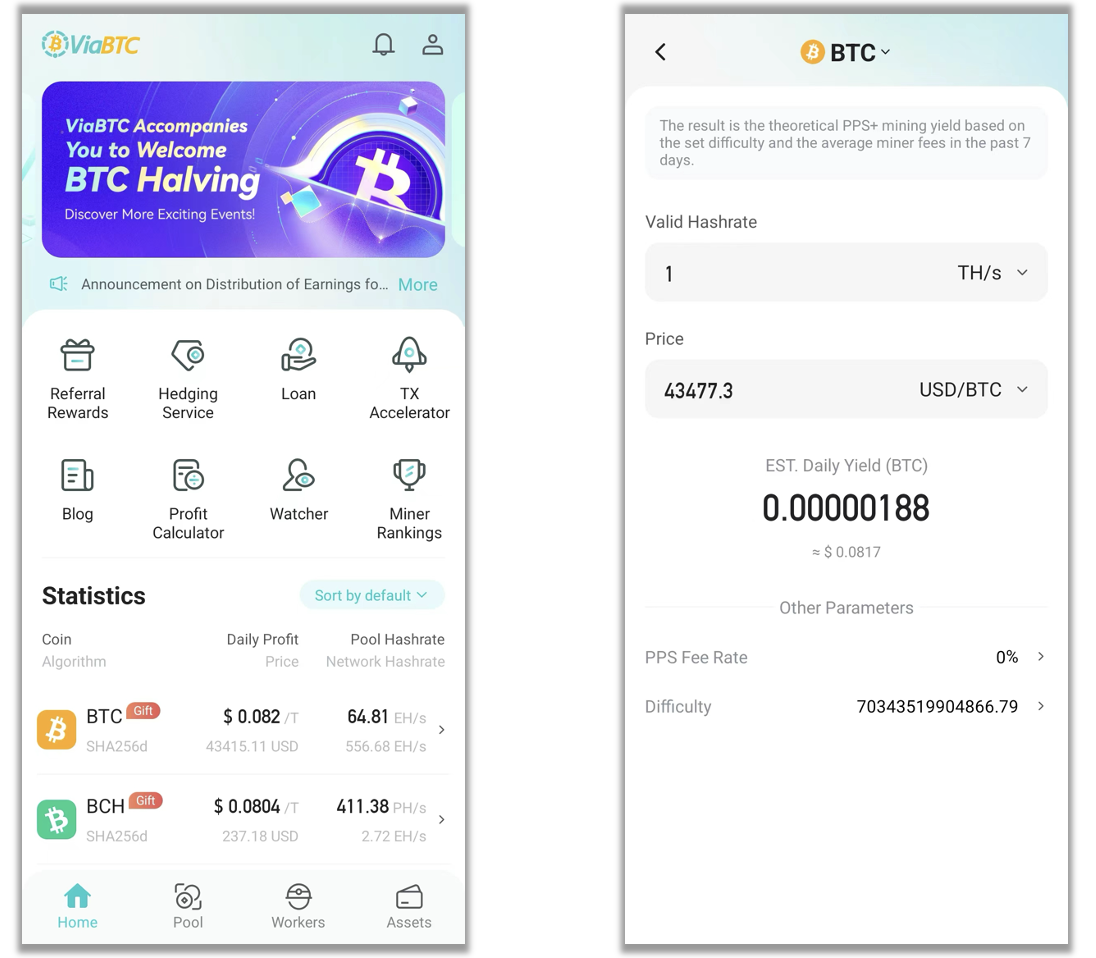Following the U.S. Securities and Exchange Commission's (SEC) approval of a Bitcoin spot exchange-traded fund (ETF), cryptocurrencies have seen a significant boost in their acceptance worldwide as investment vehicles. In 2023, the Bitcoin mining sector boasted an average revenue of $12.3 billion, eclipsing major corporations like Spotify, which earned $11.8 billion, and eBay, with $10.1 billion in revenue, presenting mining as an immensely profitable venture in the eyes of many.
Mining, however, is a nuanced endeavor. Miners employ specialized hardware to tackle cryptographic puzzles, thereby verifying and logging transactions. The profitability of mining is subject to a variety of factors such as hashrate, the current difficulty, fluctuations in crypto price, and miners fees, which makes forecasting earnings quite challenging.
The ViaBTC profit calculator emerges as a user-friendly tool in this context, allowing individuals to input several key parameters and estimate their daily earnings. This article is dedicated to explaining how to utilize the ViaBTC profit calculator effectively and the key factors to consider, aimed at empowering miners with the knowledge to make more strategic decisions.

Guide on Utilizing the ViaBTC Profit Calculator
To use the ViaBTC profit calculator, navigate to the ViaBTC official website and select "Tool - Profit Calculator" from the top menu, or access it via the "Profit Calculator" feature on the ViaBTC mobile app's home screen.
1. Choosing a Coin: Start by selecting the coin you want to calculate earnings for from the options on the left side of the page.

2. Setting the Fee Rate: On the right side, you'll find a box to input the PPS fee rate. Enter the rate here, such as 4%. The registered referee who has received a 50% fee discount coupon can adjust this rate to 2%.
3. Inputting Your Hashrate: Enter the valid hashrate of your mining rig in the designated field. ViaBTC has preset other necessary parameters like the current price of the coin, the difficulty of mining, and the potential miner fee rewards. These inputs allow the calculator to estimate your daily Bitcoin (BTC) yield. The process for entering this information in the ViaBTC app is similar.

FAQs on the ViaBTC Profit Calculator
1. Which coins are supported by the ViaBTC Profit Calculator?
The calculator is designed to estimate earnings for 11 coins that the ViaBTC mining pool supports. Currently, it's set up only to calculate earnings for the DOGE rewards that come with LTC. Calculations for other bonus coins are not available.
2. How does the ViaBTC Profit Calculator work?
It employs the PPS+ payment method to forecast earnings, which are comprised of two main components: block base rewards and miner fee rewards. The block rewards are calculated using the PPS model, which reflects the theoretical earnings based on the user's computational power. Meanwhile, miner fee rewards are determined by the PPLNS model, which depends on the actual miner fees from ViaBTC's block findings.
The calculator estimates block rewards based on the current or a custom-set mining difficulty, the user's hashrate, and the current or user-defined price. Miner fee rewards are projected using historical data.
3. How are mining difficulty, market price, and miner fees set in the ViaBTC Profit Calculator?
Mining difficulty is adjusted according to the entire network's current difficulty level, with Bitcoin, for example, undergoing adjustments every 2016 blocks (roughly every two weeks). Market prices are refreshed by automatically gathering data from exchanges, leading to potential fluctuations over time. The estimation of miner fee rewards is based on the average miner fees of blocks mined by ViaBTC over a certain period in the past, such as an average in the past seven days for BTC.
4. Do the ViaBTC Profit Calculator's Predictions Match Actual Earnings?
The ViaBTC profit calculator's forecasts cannot assure perfect alignment with actual mining profits. Real earnings are influenced by a variety of factors, including the chosen payment method, changes in mining difficulty, miner fees, and pool luck. Discrepancies may be significant, especially for miners not utilizing the PPS+, such as those opting for SOLO or PPLNS.
Fluctuations in mining difficulty have a direct impact on aligning theoretical and actual earnings, particularly noticeable around the periods when these difficulties are adjusted. The ViaBTC profit calculator, which bases its estimates on the present difficulty level, might not fully account for future changes in this variable. Moreover, the precision of the calculation is notably influenced by miner fees and the pool's luck. For instance, increases in miner fees or an improvement in the pool's luck can lead to actual profits surpassing those estimated from historical miner fees; the reverse scenario could result in lower earnings than anticipated.
Nonetheless, concerns regarding the pool's luck should be mitigated by the long-term perspective that ViaBTC's luck generally exceeds 100%. However, the landscape has recently been affected significantly by the surge in popularity of Bitcoin BRC-20 standard tokens, which has dramatically increased transaction volumes on the Bitcoin blockchain. This surge has caused substantial variability in miner fees, with fees for individual blocks at times nearing 6 BTC, roughly equivalent to the block reward, before recently settling to about 0.3-1 BTC. Such fluctuations have a considerable influence on the accuracy of the profit calculator's estimates.
Despite these uncertainties, the ViaBTC profit calculator serves as a vital tool for miners aiming to craft effective strategies and make informed decisions in the volatile cryptocurrency market. It provides essential insights, whether for newcomers to mining or experienced professionals.
Important Note: The calculator's output should be viewed as a reference point rather than a guaranteed profit figure. Miners are advised to rely on actual earnings as the ultimate benchmark.